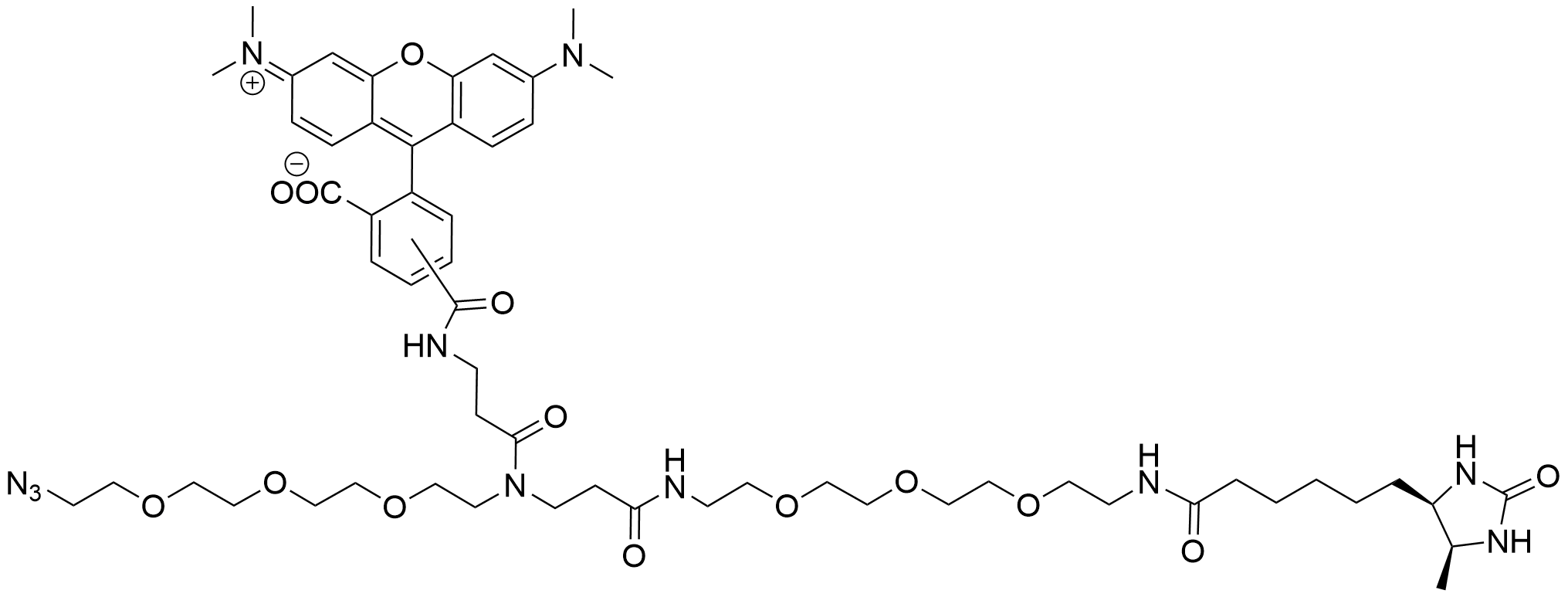TAMRA Desthiobiotin Azide
TAMRA Desthiobiotin Azide is a trifunctional probe that allows for recovery of avidin-bound protein complexes in affinity-based assays. Desthiobiotinylated proteins can be eluted readily and specifically from avidin affinity resin using mild conditions based on competitive displacement with free biotin. For pull-down experiments with biological samples, this soft-release characteristic of desthiobiotin also helps to minimize co-purification of endogenous biotinylated molecules, which remain bound to streptavidin upon elution of the target protein complexes with free biotin.
Trifunctional Click Chemistry Probes that incorporate a ligation handle, a biotin and a fluorophore have become a popular tool for for tandem labeling of proteins and subsequent detection or enrichment. However, due to the strong interaction between biotin and streptavidin harsh conditions are necessary for the elution of enriched proteins. This usually leads to contamination of the sample with non-specifically bound proteins and endogenously biotinlytated proteins, which complicates target identification.
Desthiobiotin Trifunctional Click Chemistry Probes overcome this major drawback of the streptavidin-biotin affinity purification. These probes contain a biotin moiety linked to a “clickable” group, and fluorescent dye (TAMRA). Desthiobiotin is a single-ring, sulfur-free analog of biotin that binds to streptavidin with nearly equal specificity but less affinity than biotin (Kd = 1011 vs. 1015M, respectively). Consequently, desthiobiotinylated proteins can be eluted readily and specifically from streptavidin affinity resin using mild conditions based on competitive displacement with free biotin. For pull-down experiments with biological samples, this soft-release characteristic of desthiobiotin also helps to minimize co-purification of endogenous biotinylated molecules, which remain bound to streptavidin upon elution of the target protein complexes with free biotin.
Another very important advantage of dual label probes over regular biotin probes is built-in control. Each step of enrichment process can easily followed either by UV-Vis (550 nm) or by more sensitive fluorescence spectroscopy. After elution form streptavidin beads target proteins containing TAMRA label can be easily distinguished from non-specifically bound proteins and endogenously biotinlytated proteins.
This new dual label probe should be useful to expand the new applications of standard biotin–streptavidin technology.
labeling reagent capable of covalently attaching to a terminal alkyne at one end. Unlike typical fluorescent labeling reagent, Cy5-Biotin-Azide also incorporates a biotin group. Together these features allow for both visualization and affinity purification of alkyne-tagged molecules.

Abs/Em Maxima: 346/445 nmExtinction Coefficient: 19,000Spectrally Similar Dyes: Alexa Fluor? 350, CF? 350, DyLight 350, AMCAAZDye? 350 is a blue-fluorescent azide-activated probe that reacts with terminal alkynes via a copper-catalyzed click react…
Abs/Em Maxima: 402/424 nmExtinction Coefficient: 35,000Flow Cytometry Laser Line: 405 nmMicroscopy Laser Line: 405 nmSpectrally Similar Dyes: Alexa Fluor? 405, CF? 405, Cascade Blue?, DyLight? 405AZDye? 405 Azide is a water-soluble, pH-insensiti…
Abs/Em Maxima: 346/445 nmExtinction Coefficient: 19,000Spectrally Similar Dyes: Alexa Fluor? 350, CF? 350, DyLight 350, AMCAAZDye? 350 Alkyne (Alexa Fluor? 350 Alkyne equivalent) is a blue-fluorescent, alkyne-activated probe that reacts with azid…
Abs/Em Maxima: 430/537 nmExtinction Coefficient: 15,000Spectrally Similar Dyes: Alexa Fluor? 430, CF? 430AZDye? 430 Azide is a water-soluble, green-fluorescent azide-activated probe that reacts with terminal alkynes via a copper-catalyzed click re…
Abs/Em Maxima: 346/445 nmExtinction Coefficient: 19,000Spectrally Similar Dyes: Alexa Fluor? 350, CF? 350, DyLight 350, AMCAAZDye? 350 DBCO reacts with azides via a copper-free “click chemistry” reaction to form a stable triazole and does not re…
Abs/Em Maxima: 402/424 nmExtinction Coefficient: 35,000Flow Cytometry Laser Line: 405 nmMicroscopy Laser Line: 405 nmSpectrally Similar Dyes: Alexa Fluor? 405, CF? 405, Cascade Blue?, DyLight? 405AZDye? 405 Alkyne reacts with azides via a copper…
Abs/Em Maxima: 494/517 nmExtinction Coefficient: 73.000Flow Cytometry Laser Line: 488 nmMicroscopy Laser Line: 488 nmSpectrally Similar Dyes: Fluorescein, Alexa Fluor? 488, CF? 488A, DyLight? 488, Atto? 488AZDye? 488 Azide (Alexa Fluor? 488 Azi…
Abs/Em Maxima: 402/424 nmExtinction Coefficient: 35,000Flow Cytometry Laser Line: 405 nmMicroscopy Laser Line: 405 nmSpectrally Similar Dyes: Alexa Fluor? 405, CF? 405, Cascade Blue?, DyLight? 405ZDye? 405 DBCO reacts with azides via a copper-fr…
